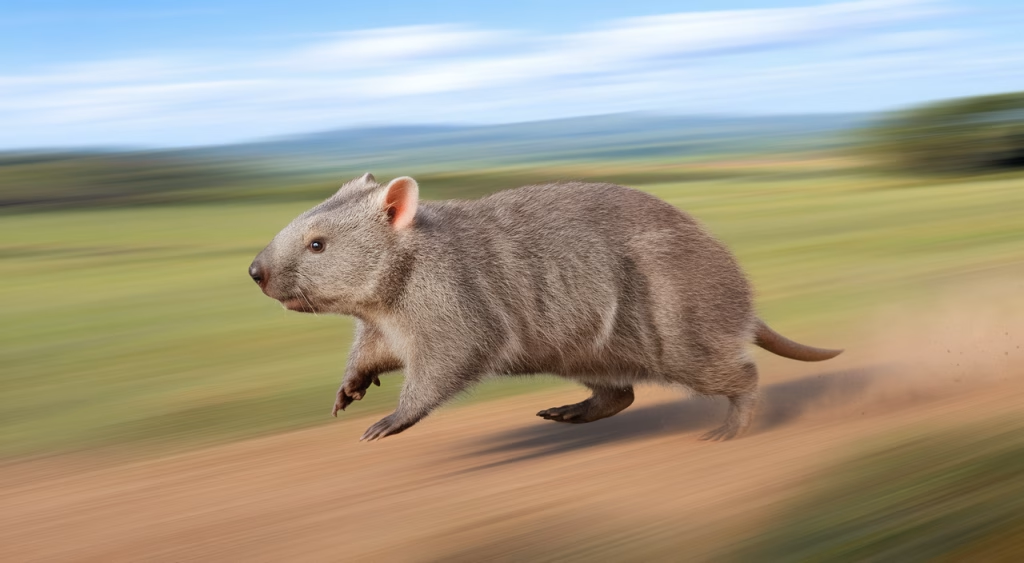Why do wombats run fast?
Wombats can run up to 25 mph (40 km/h), especially when threatened. Despite their sturdy, barrel-like build, these remarkable marsupials have evolved powerful speed bursts to escape predators—allowing them to dash to safety into their complex burrow systems. Understanding wombats speed capabilities reveals how evolution shaped these seemingly slow creatures into surprisingly agile survivors.
TL;DR: How Wombats Developed Speed to Survive
- Burst Speed: Wombats can reach up to 25 mph in short sprints.
- Predator Defense: Speed helps escape dingoes and other predators.
- Powerful Limbs: Muscular legs and low center of gravity aid traction and balance.
- Unusual Escape Tactics: Wombats bolt into burrows and use toughened rears to block entrances from predators.
- Conservation Insight: Their running behavior offers conservationists clues into habitat requirements and threats.
How Wombats Survive Predators With Lightning Speed
Ever watched a wombat scuttle off when startled? It might look slow at first—but wait a beat. That fuzzy bulldozer can explode with wombats speed, leaving a trail of dust. This isn’t accidental. In the wild, wombats are often pursued by predators like dingoes or the now-extinct Tasmanian tiger. Their quick acceleration demonstrates exactly why do wombats run fast—it’s a life-or-death adaptation.
Wombats are burrowing marsupials that often inhabit densely forested or mountainous terrain. These environments don’t just mask sound—they create natural escape routes that make short sprints incredibly effective. The wombat’s sprint is all about reaching safety in their burrow. Here’s where wombat behavior under threat gets fascinating: once a wombat slides into its tunnel, it may use its toughened rear—hardened by cartilage and muscle—to block the entrance, preventing predators from pulling it out.
You’ll notice wombats don’t run long distances. Their speed showcases wombat agility designed specifically for high-stress threat scenarios. They’re specialists in short, explosive dashes—like sprinters with natural armor who know exactly when speed matters most.
The Anatomy Behind Wombat Speed Adaptations
Let’s bust your mental image of the wombat as just a pudgy, lazy grazer. Beneath that bear-like coat lies an all-terrain, muscular machine optimized for sudden dashes and powerful digging. Understanding wombat anatomy for speed reveals the engineering behind their survival strategy and explains their remarkable wombat behavior under threat.
Here are the key wombat speed adaptations:
| Adaptation | Function |
|---|---|
| Compact, muscular body | Minimizes wind resistance and conserves energy |
| Short legs with powerful claws | Digging and propulsion for speed bursts |
| Low center of gravity | Improves balance on uneven terrain |
| Thick-skinned rear | Serves as a shield in burrow defense |
Think of wombat anatomy for speed like an off-road vehicle—it’s not designed for drag racing, but it can power through tough terrain without tipping over. Their metabolic rate is slow (great for energy conservation), but their muscles are primed for the explosive wombat agility that saves lives.
And yes, it’s true: their soft-looking behind is actually a wedge-shaped defense mechanism hardened by cartilage and particularly effective at blocking burrow entries from determined attackers—a perfect complement to their speed-based escape strategy.
Surprising Facts About Wombats Speed and Agility
Now that you understand why do wombats run fast, here are mind-blowing details about these agile Australian icons that showcase their remarkable wombats speed capabilities:
- Speed Record: Wombats have been clocked running at up to 25 mph (about 40 km/h)—matching human sprinter speeds with their compact build.
- Tactical Rear Defense: A wombat’s rump isn’t just for show. When threatened, wombats back into their burrows and use their hard rears to ram or trap would-be predators—the perfect follow-up to their speed escape.
- Extensive Burrow Networks: Some wombat burrows stretch over 100 feet long. These tunnels serve as highways to safety where wombat agility is crucial for reaching entry points quickly.
- Galloping Technique: Although they waddle when walking, wombats transition into a galloping motion when sprinting—showcasing their true wombat speed adaptations like a furry locomotive on turbo.
- Slow Digestion vs. Fast Escape: Wombats digest food over 14 days but can move with lightning wombats speed when their lives depend on it!
Wombat Conservation Efforts: Protecting Speed and Habitat
Protecting these speedy marsupials requires understanding that their remarkable wombats speed means nothing without proper habitat. Wombat conservation efforts focus heavily on wombat habitat preservation and managing modern threats—from habitat loss and climate change to road mortality and diseases like sarcoptic mange that can impact their ability to escape predators.
Why Habitat Preservation Supports Wombat Speed Survival
Wombats rely on their environment to make their speed effective. Open pastures make them sitting ducks, while forests and scrublands offer the tunnels, cover, and escape routes that complement their wombat agility. That’s why agencies and sanctuaries work hard to restore and link fragmented habitats—because without proper hiding places, even 25 mph speeds can’t guarantee survival.
Climate events like floods or prolonged droughts push wombats into less suitable habitats, often closer to roads and residential areas. This leads to higher vehicle strikes and increased human-wombat conflict. Modern wombat conservation efforts now include wildlife crossings, disease treatment programs, and burrow protection zones that respect their need for speed-friendly environments.
Public awareness about why do wombats run fast plays a crucial role in conservation success. When people understand wombat behavior under threat and their impressive wombat speed adaptations, they’re more likely to support habitat preservation efforts that let these remarkable marsupials thrive.
Final Thoughts: Compact Marsupials With Olympic-Level Speed
Wombats might not look the part, but underneath their cuddly exterior lies an animal engineered for sudden acceleration and intelligent defense. At up to 25 mph, their bursts of wombats speed aren’t just impressive—they’re essential survival tools. These remarkable wombat speed adaptations, refined through thousands of years of evolution, demonstrate perfectly why do wombats run fast: to escape danger and live another day.
For wombats, wombat agility isn’t about thrill-seeking—it’s about survival. As wildlife enthusiasts, appreciating their unexpected speed capabilities connects us more deeply to Australia’s incredible biodiversity. Whether you’re marveling at their effective wombat anatomy for speed or supporting wombat conservation efforts, every sprint tells a story of resilience, adaptation, and the raw determination to keep moving forward in the face of danger.
Frequently Asked Questions
-
How fast can wombats run?
Wombats can run up to 25 mph (40 km/h) in short bursts when threatened or startled. -
Why do wombats need to run fast?
They use their speed to evade predators and return quickly to the safety of their burrow networks. -
What predators do wombats face in the wild?
Dingoes, large birds of prey, and wild dogs are common threats. Historically, Tasmanian tigers also preyed on wombats. -
Is a wombat’s rear really armor?
Yes! The wombat’s rear is hardened with cartilage to shield it from predators and block tunnel entrances. -
How are conservationists protecting wombats?
Through habitat restoration, disease treatment programs, public awareness campaigns, and wildlife crossings near roads. -
Do wombats use their speed often?
No, only when threatened or startled. Most of the time, they move slowly and deliberately.





